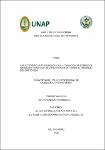Características epidemiológicas y condición de egreso de pacientes con covid-19 atendidos en el Hospital Regional de Loreto 2020
Abstract
The objective was to determine the relationship that exists between the epidemiological characteristics of person, time and place and the discharge condition of patients with COVID-19 treated at the Regional Hospital of Loreto 2020. The method was quantitative and the design was non-experimental, descriptive. , correlational, retrospective. The population and sample consisted of 203 medical records of patients with COVID-19. The technique was documentary review and the instruments were the epidemiological characteristics data sheet and the patient's discharge condition identification data sheet. The SPSS statistical package was used for data processing and the chi-square statistical test (x2) for correlational analysis. The results were: 62.6% were between 30 and 59 years old, 61.1% were men, 95.6% had independent occupation, 21.2% had hypertension, 12.8% diabetes, 2.5% obesity, 88.7% presented a severe level of COVID-19 disease, 54.7% came from urban areas, 88.7% were treated in the emergency service, 48.8% had a period of illness from 4 to 7 days, 66% had a hospitalization time in Medicine/ICU of less than 7 days. Regarding the patient's discharge condition, 70% resulted in a recovered condition and 30% died. It is concluded that there is a significant relationship between age (p= 0.000), occupation (p= 0.000), hypertension (p= 0.000), diabetes (p= 0.000), disease severity (p= 0.002), origin (p= 0.030), service where care was taken (p= 0.001), time of illness (p= 0.000), hospitalization time of the patient (p= 0.000) with the condition of discharge and no significant relationship was found with sex (p= 0.585 ) and obesity (p= 0.623). El objetivo fue determinar la relación que existe entre las características epidemiológicas de persona, tiempo y lugar y la condición de egreso de pacientes con COVID-19 atendidos en el Hospital Regional de Loreto 2020. El método fue el cuantitativo y el diseño no experimental, descriptivo, correlacional, retrospectivo. La población y muestra estuvieron conformadas por 203 historias clínicas de pacientes con COVID-19. La técnica fue la revisión documentaria y los instrumentos fueron la Ficha de datos de características epidemiológicas y Ficha de datos de identificación de condición de egreso del paciente. Para el procesamiento de datos se utilizó el paquete estadístico SPSS y para el análisis correlacional la prueba estadística chi cuadrada (x2). Los resultados fueron: el 62,6% tenían de 30 a 59 años, el 61,1%, eran hombres, el 95,6% tenían ocupación independiente, el 21.2% tenían hipertensión, el 12.8% diabetes, el 2.5% obesidad, el 88,7% presentó un nivel grave de enfermedad del COVID-19, el 54,7% procedían de zona urbana, al 88,7% se les atendió en el servicio de emergencia, el 48,8% tuvieron un tiempo de enfermedad de 4 a 7 días, el 66% tuvieron un tiempo de hospitalización en Medicina/UCI menor de 7 días. Sobre la condición de egreso del paciente, el 70% resultaron en condición de recuperados y el 30% fallecidos. Se concluye que, existe relación significativa entre la edad (p=0,000), ocupación (p= 0,000), hipertensión (p= 0,000), diabetes (p= 0,000), gravedad de enfermedad (p= 0,002), procedencia (p= 0,030), servicio donde se atendió (p= 0,001), tiempo de enfermedad (p= 0,000), tiempo de hospitalización del paciente (p= 0,000) con la condición de egreso y no se encontró relación significativa con el sexo (p= 0,585) y obesidad (p= 0,623).
Collections
- Tesis [251]


